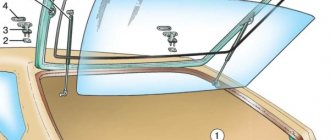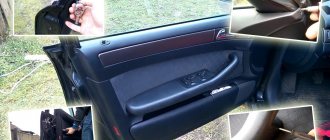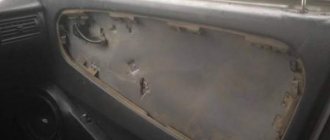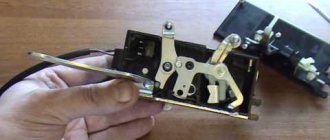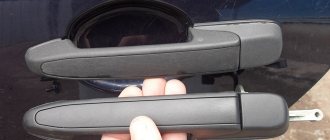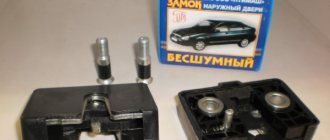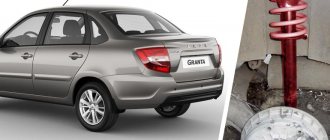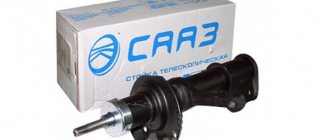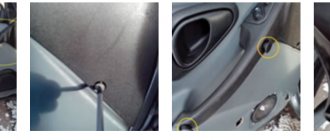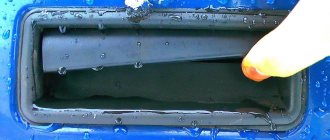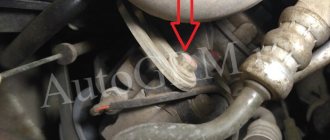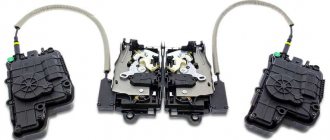The process of removing the trim from the rear door
Painting, straightening, any welding work - these are situations in which it is necessary to remove the rear door . Or this is done in the case when the presence of such an element interferes with the organization of any other work.
First, prepare the necessary set of tools. Then they move on to the actions themselves, the sequence of which is standard :
- The minus terminal is disconnected from the battery to de-energize the entire vehicle. The driver's steering wheel is no exception. The bolts securing the door opening limiter are unscrewed with a ten-point socket.
- Rubber protection elements are removed from the wires that fit under the door. By squeezing the plastic clamp, the pads are disconnected from each other.
The retaining clips are removed from the door hinges using a flathead screwdriver . It is quite easy to pry the indicated space with it.
The door must be pulled up along the axes with a hinge to be removed from its place . At this stage, the repair work can be considered almost complete. Installation is in reverse order. The door mechanism is checked for functionality.
This is interesting: Chevrolet Niva windshield repair
Dismantling and assembling the front door of Chevrolet Niva
Squeeze the tabs of the latch and remove button 4 (see Fig. 8-43) to disable the door lock.
Remove three key switches on the left door and one on the right, disconnect the plug blocks, remove plugs 5 (Fig. 8-41), unscrew screws 3 and 4 securing handle 10 of door armrest 12, remove armrest handle and side mirror trim. Unscrew the screw securing the trim 1, move it back and remove the trim of the inner door handle 2. Unscrew three self-tapping screws 6 (see Fig. 8-40) and remove pocket 9 of the front door trim. Unscrew the two screws, press button 2 with a screwdriver and remove the upholstery 13. Disconnect the plug blocks of the wiring harnesses of the exterior mirror gear motor and the front door wires. Unscrew three screws 12 (see Fig. 8-52) and remove the outside mirror. Remove the outer lower and upper sliding window seals. Temporarily install the key switches, connect the negative terminal to the battery, and raise the sliding window. Remove the key switches and disconnect the negative terminal from the battery. Unscrew the bolt and remove guide 1 (Fig. 8-42) of the sliding glass assembly with seal 2.
Through the openings in the inner door panel, unscrew the two bolts 8 securing the frame 7 of the sliding glass 3 to the window lifter and remove the glass from the door cavity. Disconnect block 10 (Fig. 8-44) of the wiring harness for gear motor 9 of the power window from the block of the side door wiring harness. Unscrew the four nuts 5 securing the window regulator and remove it complete with the gear motor through the opening in the inner door panel. Unscrew two screws 6 (see Fig. 8-41) securing the internal handle 2 of the door lock drive, disconnect rod 1 (see Fig. 8-43) and remove the handle. Disconnect rods 5 and 7 of the outer handle from lock 9. Unscrew the nut and bolt and remove handle 4 (see Fig. 8-41) assembled with rods 5 and 7 (see Fig. 814). Unscrew the three screws and remove lock 9 (see Fig. 8-43) assembled with rods 1 and 2.
Unscrew the three bolts securing the door limiter and remove it. Remove the wiring harness from the door cavity.
Video about “Disassembling and assembling the front door” for Chevrolet Niva
VAZ 2121 Niva, door repair (part No. 9) Door repair VAZ 21213 (Niva)
Source
The process of dismantling the front door trim from a Chevrolet Niva
There are various reasons why there is a need to carry out such work . For example, when repairing a door mechanism or installing additional speakers. The work is easy to do yourself, you just need to spend some time studying the nuances.
The procedure is not at all complicated.
- The inner handle has two plugs; under them there are mounting screws for this design. To remove the plugs, just poke at the structure with a sharp object.
- Use a screwdriver to unscrew the screws from the armrest, and the latter is removed.
- Three screws hold a special pocket on the plastic, with which you can store various items inside. The screws themselves are located at the bottom.
- The plastic cover of the handle for opening the door is dismantled next. The handle is unscrewed, then the screw inside is removed. Remove the decorative trim by pulling part of the part towards you. The main thing is that the trunk is not damaged.
After this stage, everything is ready to get rid of the outer skin . Plastic dowels hold the product to the base. The keys are removed from the holes in the door sequentially - they are passed along the entire perimeter with tools. After this, there should be no problems with removing the trim in front.
Design of silent locks
The silent mechanisms are equipped with an internal latch. Thanks to this part, opening/closing occurs without any extraneous sounds. An additional pad on the body pillar ensures silent slamming of the doors. The silent device will not require adjustment. If the factory lock is out of order, then it is better to replace it with a design of European quality.
Removing and installing the tailgate lock
Disconnect the negative terminal of the battery.
Remove the tailgate trim as described above.
Disconnect the wiring connectors for the trunk light switch and the electric drive.
Use a flat-head screwdriver to pry and disconnect the lock switch rod end from the door handle
Use a screwdriver to pry the door handle rod off the lock lever.
Use a Phillips screwdriver to unscrew the three screws securing the lock to the door.
Using a Phillips screwdriver, unscrew the two screws
Removing the electric locking drive
Install the lock in reverse order
Castle repair
After removing the device, you can disassemble the Euro-lock to eliminate its malfunction. When the protective plastic fasteners are unscrewed, you will be able to gain access to the rod. It can be removed with an impact screwdriver and a wrench. The rod is connected to a latch and a switch. Further instructions:
After a careful visual inspection, the cause of the failure is determined. The spring is being replaced, lubricated, parts are cleaned of dirt, pins are adjusted, and corrosion is removed.
After repair, assembly is performed in reverse order.
Trim tuning: different solutions
Tuning of the interior parts is carried out to increase the comfort of passengers and the driver . The modern market offers many solutions, with different characteristics and features.
Interior insulation: what materials are used
The most common solutions:
- Madeleine. A type of seal with a fabric base.
- Bitoplast. Prevents so-called skips. It is distinguished by the presence of a sticky layer that simplifies fixation.
- Stizol. Suitable not only as a sound insulator, but also to contain heat inside.
- Isotone. It has excellent performance in absorbing sound waves.
- Vibroplast. Increased elasticity is the main characteristic due to which the base has become so widespread.
- Vizomat. Self-adhesive substance capable of absorbing vibrations of any type. The basis of impregnation is bitumen mastic. A closed car provides complete protection.
To get the job done, several materials are selected; it is not necessary to combine them all . Increasingly, they are abandoning glass wool, which too quickly loses its original qualities when in contact with moisture.
Interior insulation and main steps
First, the entire interior is dismantled .
Materials with insulating properties are laid only on bare metal , which remains completely free. Be sure to remove traces of old rust and paint. The key is to be careful, which is why dismantling often takes the longest.
Laying of the selected materials is carried out immediately after completion of the preparatory stage . All air ducts must remain open; they prevent the formation of moisture inside the cabin.
Various methods are chosen to secure materials . Some require special glue, while others have a layer present to solve the same issue from the very beginning. Once the materials are in place, the entire interior is put back together.
The most attention is paid to door insulation . After all, this is where the most noise occurs, since they have to be opened constantly.
Interior tuning and basic methods
There are several ways that provide increased comfort to the driver and passengers:
- LED tuning using the dashboard.
- Installation of additional diode strips serving as light sources.
- Installation of speakers, radio. Many people like high-quality sound inside the car. Replacing standard music systems gives excellent results.
- Interior reupholstery with torpedo.
- Installation of chrome decorative elements that attract attention. For example, where there is a passenger view of the doors.
Upholstery reupholstery
Standard materials retain their integrity for a long time, but the insulating qualities of such bases leave much to be desired. And the appearance rarely satisfies owners from the very beginning.
When choosing a suitable solution, experts recommend relying on the following criteria:
- Attention is paid to the shade of the stitching if it is clearly expressed in the future product. Isolating this detail against the general background only emphasizes the overall style.
- The ceiling surface is often left virtually unchanged. Then other colors are adjusted to the existing design.
- 45% to 55% is a basic combination of two colors that is used in most cases. Then the solution itself looks more interesting.
- Special color schemes make selection easy. They will allow you to quickly understand which design option is best suited for the internal filling of the car.
- The optimal solution is upholstery that matches the color of the body. It is important to create harmony, but at the same time the elements must be similar to each other. Disassembling the entire interior is not required if done correctly.
Black upholstery material and light stitching are poor decisions . Because of this combination, all the shortcomings become noticeable.
The next stage is the selection of the material whose characteristics are most suitable.
For interior trim, preference is usually given to:
- corduroy;
- substitute for genuine leather;
- faux suede;
- velor;
- skin.
You shouldn’t trust the first online store you come across to make a purchase. When choosing materials, be sure to check the quality .
The traction is broken.
Basically, the rod can bend if it was assembled incorrectly. The problem can also appear if the car is often used in off-road conditions and dirt gets into the cavity. This can happen if the plastic film peels off from the door frame. In this case, dust may accumulate inside it.
During movement, dust settles not only at the bottom of the cavity, but also on all components, including the levers. After the car gets caught in the rain or washed, all the dust turns into dirt, firmly settling on the insides. As it accumulates, it leads to a decrease in the lock stroke, and at the moment when the passenger tries to open the door, great efforts have to be made. Because of this, the rod begins to bend over time. And at some point its progress is not enough to unlock it. Even after it is straightened, the integrity of the system will already be compromised and components will need to be replaced.
Reupholstering doors and panels with glue
Reupholstering complex surfaces raises the most questions , even among experienced craftsmen.
But it would be a good idea to familiarize yourself with the main nuances :
- First prepare the surface. Washing, sanding and degreasing are mandatory steps. Then the adhesion of materials increases, they adhere to each other faster and better. Special substances will help cope with degreasing.
- Next, glue is applied to the working surfaces and the material used. Applying with a brush helps with areas that have a lot of unevenness.
- Heating with a hair dryer promotes faster and better adhesion. Materials become more elastic.
This is interesting: Ignition switch wiring diagram
Spring failure
If cracks and serious mechanical damage appear in the spring, there is a high probability that the lock will also fail . In such a situation, one of the levers that operates inside the machine is overloaded. The tendrils of the spring break off, after which the lever with which the clutch is organized becomes completely unpredictable.
Even complete blocking in this case does not protect the doors from opening while moving . Springs that were originally made from low quality material are more susceptible to defects. An incorrectly selected metal grade can also affect further operation. Even if it is only a passenger type of design.
Step-by-step repair of the mechanism is as follows:
- The rear door trim is removed.
- Study the settings.
- Change or reinstall parts.
Chevrolet Niva. disassemble the back door.
The door trim of a Chevrolet Niva car plays a role in arranging the interior design of the cabin. Without it, it would be very difficult to call the salon comfortable and elegant. But it acts not only as a piece of furniture, but also serves as some protection from extraneous noise. Let's consider the main purposes of the door trim of a Niva Chevrolet SUV, its removal and installation.
Why do you need door trim?
This element is made of plastic and hides the inner surface of all doors in the Chevrolet Niva. There may be other decorative elements on top of the plastic on the upholstery .
The inner surface of the Niva Chevrolet doors is lined with plastic.
Purpose:
- Hides the metal base of the door.
- Gives the salon style.
- It has a handle on its surface for opening/closing the door.
- Reduces the level of external noise in the cabin.
- Serves as a place to install speakers and store small items in pockets.
Removing the limit switch from the Chevy Niva door lock
This way we remove the glass frame. Next, unscrew the filler plug and remove the neck trim of the tailgate glass washer reservoir. Carefully pry up the upholstery with a screwdriver and remove the pistons. During work there is a danger of damaging the painted surface.
There will not be a serious dent, but a scratch may still remain, so it is recommended to wrap the end of the screwdriver with insulating tape. The upholstery is put back in place in the reverse order.
If the pistons are damaged, they must be replaced with new ones. Let's move on to the tailgate lock drive.
The same screwdriver will come in handy during the process. The rear door door card is removed even when the door is locked. First, unscrew the two screws from the bottom of the door card. Remove the window handle by bending the handle with a flat screwdriver and pulling the latch upward.
Replacing the lock cylinder on a Chevrolet Niva
Unscrew the screw securing the decorative trim under the door handle, pulling the handle towards you. The door card is held on by six pistons - two at the bottom, two at the center and two at the top. They snap off if you pry them with a long screwdriver.
The door card can now be removed. Video about removing the lock on a Niva Chevrolet Opening the door The lock can be unlocked by pulling the plastic tongue of the actuator or another lever, using a long screwdriver, you can move the lock latch itself. When the door has opened, you can remove the lock, but before that you need to remove the negative terminal from the battery.
The lock is held on by fastening screws at the end of the door. After removing them with a long screwdriver, you need to remove the drive rods, disconnect the terminal blocks and remove the lock from the door cavity along with the actuator. After this, when the lock is in hand, the reason will become visible. In extreme cases, the lock can be replaced.
The four-door body of the Niva Chevrolet, in comparison with the Niva 2121, looked like just a limousine. What a shame it is for Shnivy owners when this body turns into a three-door. What to do when the back door on a Chevrolet Niva does not open, we will consider the reasons and solutions to the situation right now.
Eliminating play in Shevik door handles
The handles on the doors had been dangling for a long time, but when yesterday I saw how far the right front handle had moved, I decided to go through them all.
First, let's disassemble the front door. I already wrote how to do this in the topic about installing front tweeters. Next, we bend the polyethylene to access the internal fastening of the handle:
I thought that it was he who had loosened, but it turned out to be properly tightened. Therefore, the handle had to be disassembled further)) The second screw securing the handle on the front door is located here:
It is not necessary to remove the handle, just put it in this position:
It was this screw in the front of the handle that was loosened:
Just in case, I unscrewed the screw and saw that the silumin tongue had been broken off. To calm things down, I glued it with superglue)) Although I understand that this won’t last long:
If the tongue is broken, then the front part of the handle is held only by a self-tapping screw. By the way, they were broken off on all the doors)) After assembly, the play disappeared.
To disassemble the rear door, you first need to remove the retaining ring under the window lifter handle:
After which the window lifter handle will be removed. Remove the trim around the inside door opening handle (similar to the front door), unscrew the screws for the T20 sprocket: one in the armrest and two at the bottom of the door:
Then we pull off the door trim, trying not to break the fastening pins. Here's where they are:
The outer rear door lock screw is located here:
In addition, it was not possible to turn the handle outward, as on the front doors, so I inserted a screwdriver through the hole in the door, pulling the handle:
Then we remove the plastic pieces to the right and left of the glass, for which we unscrew 3 screws for a screwdriver and 2 for a T20 sprocket, hidden under round plugs (on the left plastic piece, the lower screw for a screwdriver is long):
Unscrew the lid of the washer reservoir and take out the rubber band underneath:
After this, you can remove the rear door trim, but you need to do this carefully, helping with a flat-head screwdriver, since the pistons on it are more powerful than on the side doors, there is a possibility of breaking off the fasteners on the inside of the trim. If you break off the piston together with the bracket, superglue will help you; glue it directly on top of the old glue. The rear door handle outer screw is located here:
This is the only screw with a 10mm wrench, all other external and internal screws and lock nuts are 8mm wrenches.
Well, at the same time I lubricated the door stops with lithol so that they wouldn’t rustle:
The only thing I didn't disassemble was the right rear handle - it had no play at all.
Source
Tips for using sewing machines
General recommendations for better results:
- The surface and elements are prepared for further use of the pattern.
- Paper is used as a blank, where the elements are transferred.
- Lines along which further work is carried out are marked on the material.
- The stitching of the material is carried out along the lines outlined in advance. Afterwards everything is stitched.
- Excess parts are carefully trimmed.
- The adhesive composition is applied to the reverse side. After which the products are connected to each other.
- The main thing is to protect the front surface from glue. Removing it does not cause any trouble.
What causes the lock to stop working?
The problem practically bypasses Nivas operating in the city. But for those who often drive on country roads, the problem will be very familiar. In any case, they already know what to do, but this article was written for those who are encountering this for the first time.
First of all, this is dust that gets clogged under the door trim. During operation, dust accumulates and causes the lock mechanism to jam. As a result, the central locking does not work. But the larva will stop working first. Eventually, the lock stops locking with both the key and the key fob.
It is recommended to constantly check that the trunk door is closed before leaving the car. This malfunction occurs suddenly and many car owners have had their cars left open to thieves for years.
